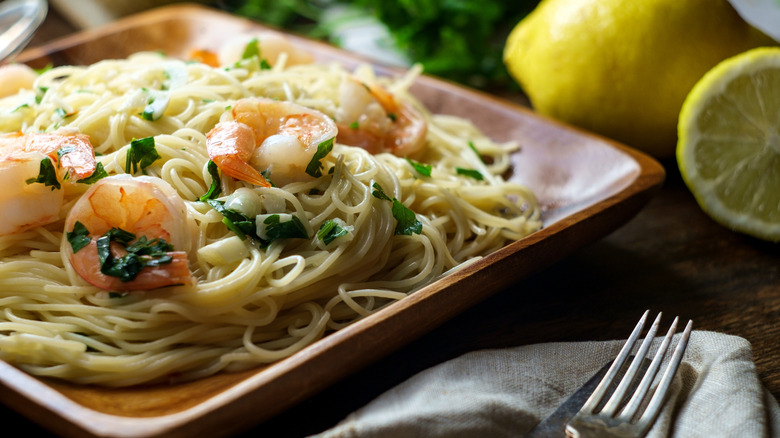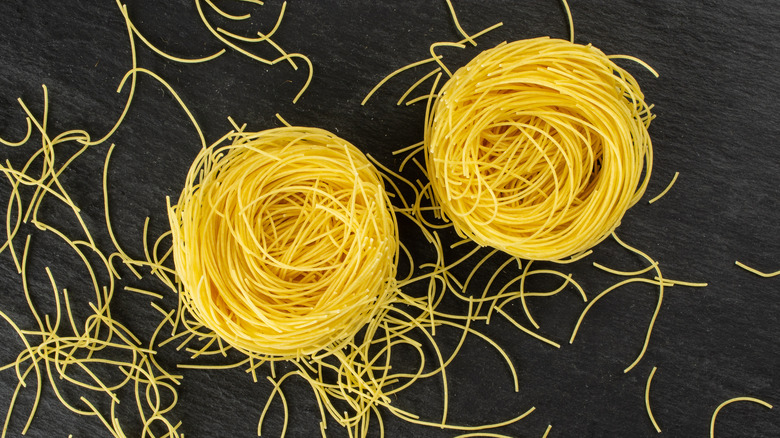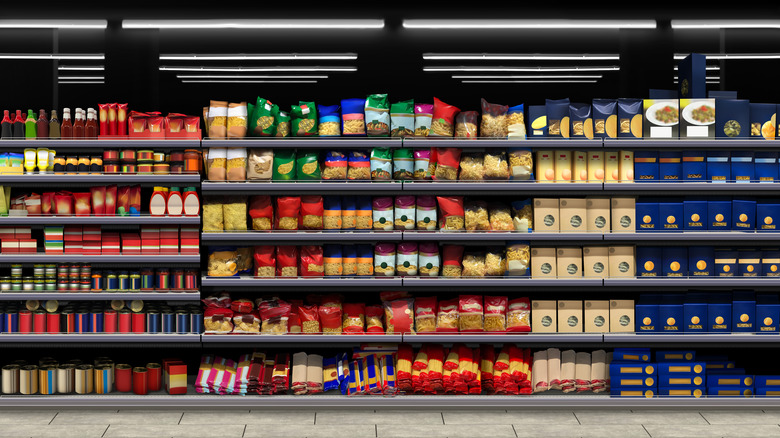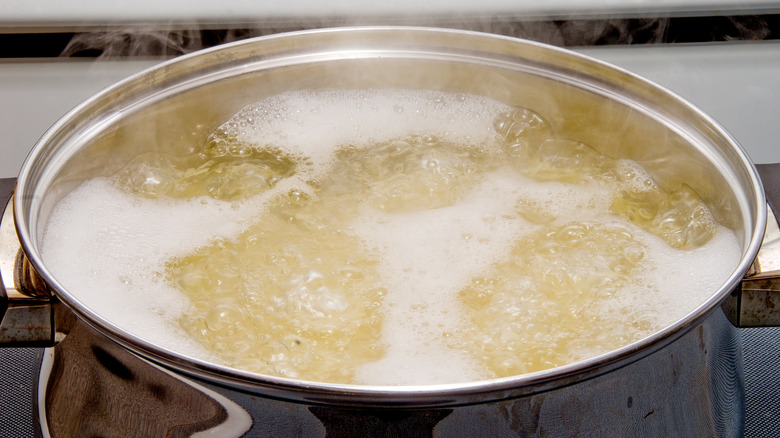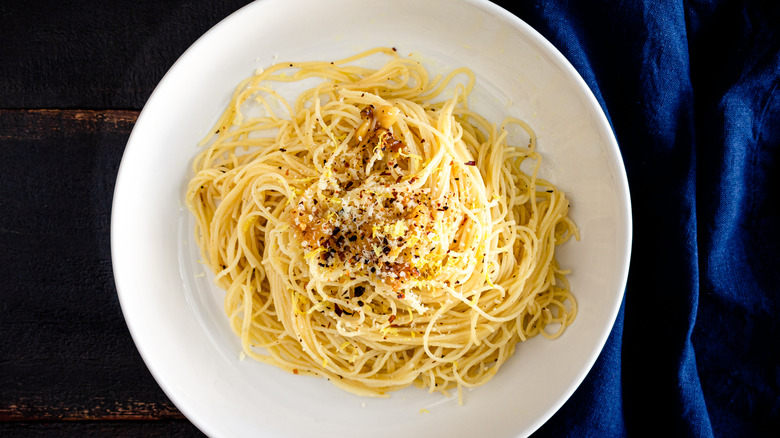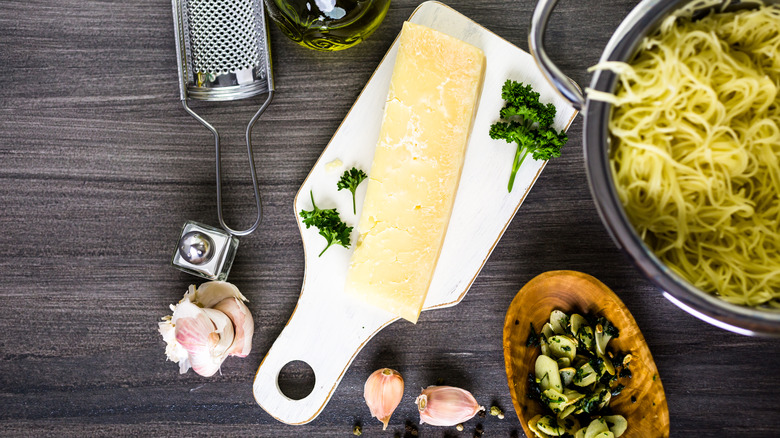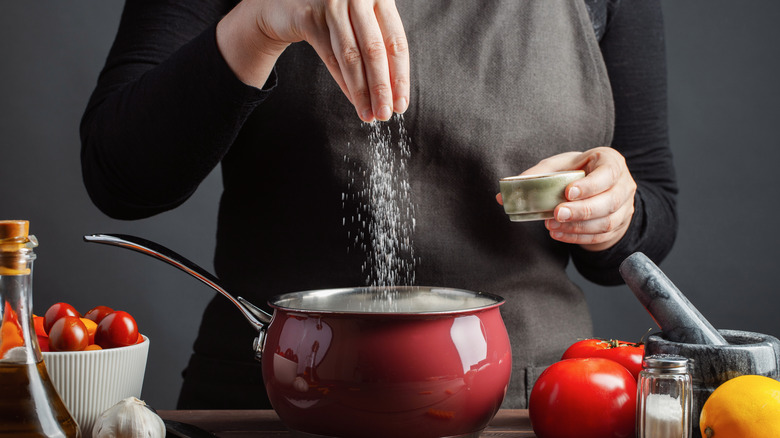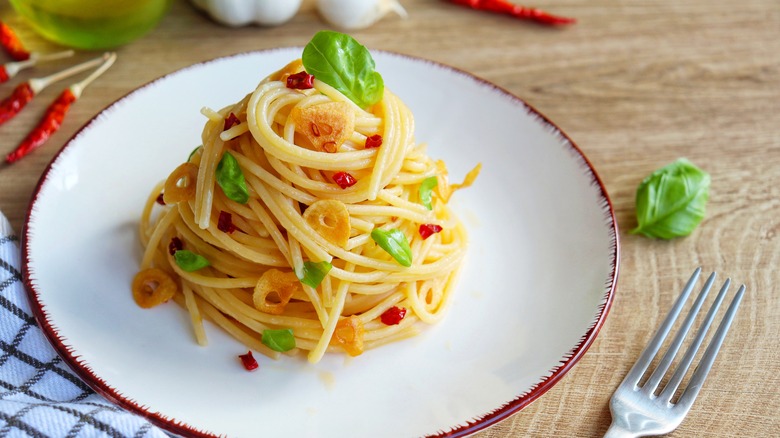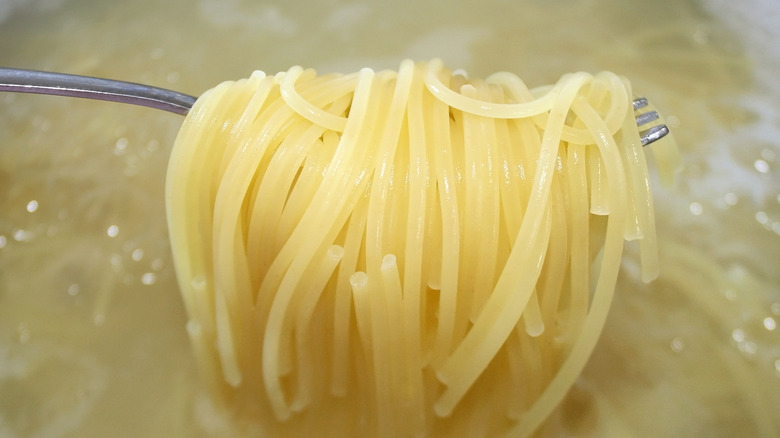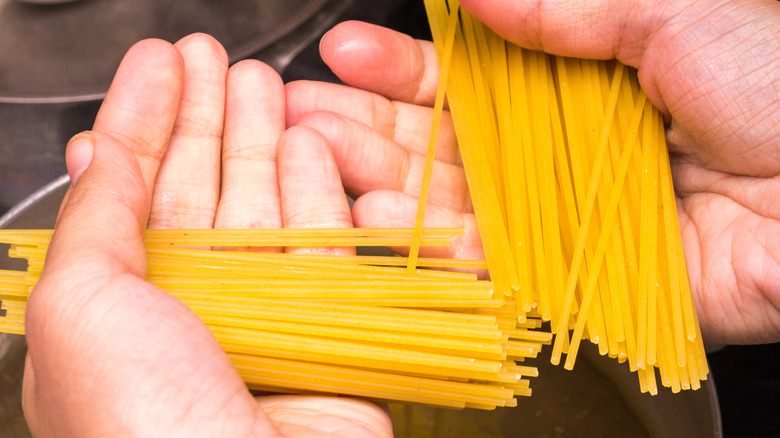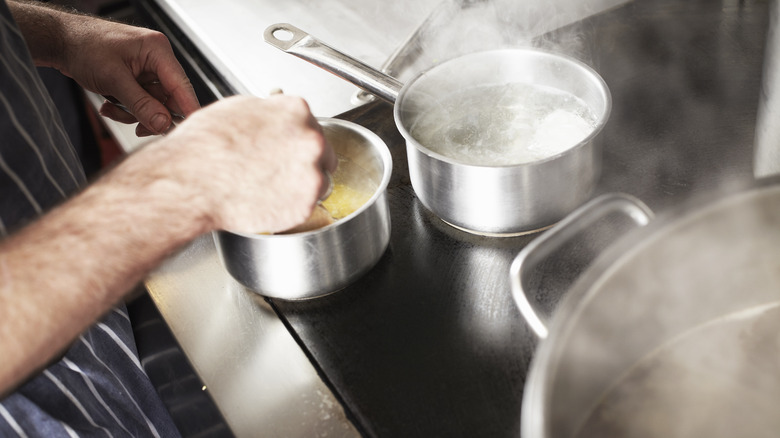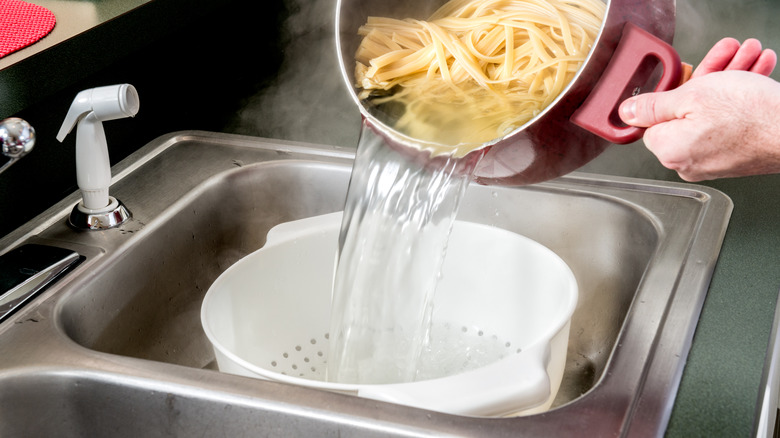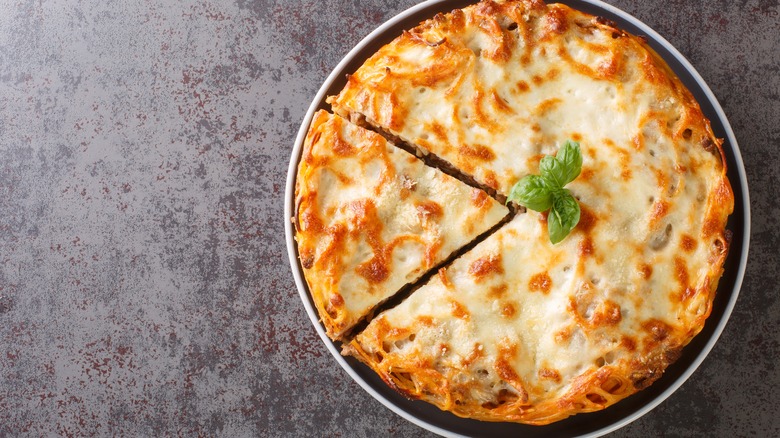Why Angel Hair Pasta Always Tastes Different At Restaurants
Angel hair pasta's name is aptly evocative: This super skinny noodle is indeed as delicate as its ethereal name suggests. If you've never encountered it, think of it as a thinner iteration of spaghetti that, when cooked right, transforms into a delicate pile of impeccably al dente strands. But its delicate texture can also be angel hair pasta's biggest downfall. Seeing as it's so thin, angel hair cooks incredibly quickly, and this short cooking time makes it even less forgiving than most. As a result, angel hair is one of the easier pastas to flub, and cooks who aren't careful — whether in professional kitchens or at home — might see angel hair quickly transform from toothsome and moreish into a gloppy, too-soft mess.
Luckily, there are some tips and tricks to help you ensure you always succeed when preparing angel hair pasta, ranging from taking the time to do your prep and mise en place properly to choosing the right sauce to help angel hair pasta really shine. We've tapped some industry experts to delve into some of the most common mistakes home cooks make when preparing angel hair pasta, and they've shared all of their best tips and tricks to help you reach the coveted ideal of truly heavenly angel hair pasta.
You're confusing angel hair pasta with capellini
You may find your angel hair doesn't live up to the hype if you confuse it with its closest cousin, capellini. Italian for "little hairs," capellini is "a 'hair' larger than angel hair," explains All-Purpose Pizzeria's Chef Mike Friedman. And a hair, in this case, is a matter, not of millimeters, but rather of micrometers: Capellini has a diameter of between 0.85 and 0.92 millimeters, while angel hair is about 0.78 to 0.88 millimeters. Indeed, Chef Glenn Rolnick, culinary director of Alicart Restaurant Group, which includes Carmine's and Virgil's Real BBQ, notes that while "angel hair pasta is slightly thinner than capellini in diameter (...) many won't see the difference."
By and large, this slight discrepancy — and potential for confusion — isn't a massive problem, according to Chef Leah Cohen, owner of Pig & Khao in New York. "In general," she says, "the differences between angel hair and capellini are minimal so, really, you can use either one in your dishes based on personal preference or [its] availability."
But one place where it does make a difference is in cooking time. While the difference isn't obvious to the naked eye, there is indeed a difference, and in confusing the pastas, you run the risk of cooking angel hair for as long as capellini requires, overcooking the delicate strands in a matter of seconds.
Angel hair pasta varies from brand to brand
The quality of pasta can vary widely from brand to brand — and this holds true for all shapes, not just angel hair pasta. From agnolotti all the way to ziti, choosing a cheap pasta brand may lead to a ho-hum dinner. "Always use De Cecco pasta for an authentic Italian meal," advises Louie Sparagis, owner of The Shady Lady, Crave Astoria, and The Oven Pizzeria. "In a pinch use Colavita or Barilla."
Executive Chef Matt Smith of Alta Strada Mosaic suggests scanning the ingredients list of your angel hair pasta before you make a purchase: Durum wheat is a good sign, he says, showing that the brand is eschewing lesser-quality flours. "Look for something made in Italy preferably," he suggests, "especially something bronze die extruded."
"Different brands often have different quality — it's a given," echoes Cohen ... but she goes a step further when it comes to discrepancies among pasta brands when it comes to angel hair pasta specifically. In this case, different brands won't just boast differences in quality but differences in size.
"When choosing a specific brand of angel hair pasta, it's important to ensure the brand you go with sells the size you like," she says. "Not every angel hair pasta is the same size, and the smaller/thinner the pasta, the harder it'll be to cook."
You're probably cooking angel hair pasta for too long
The number-one, make-or-break issue concerning angel hair pasta comes down to cook time. Indeed, for Sparagis, "the most common mistake" people make with angel hair pasta is overcooking it. And this is easy to do even if you've got the right brand and the right size. A matter of seconds can push it past al dente, seeing as angel hair really only needs to cook for three to four minutes. According to Smith, "being that thin leaves no room for error."
"An extra minute of cooking can take it from al dente to no bite," adds Rolnick. And this holds even more true if you're adding it to a sauce, in which case, according to Sparagis, "it will keep cooking." It's for this reason that Smith recommends undercooking angel hair slightly. "Like with any pasta," he says, "cooking a minute less than recommended helps."
That said, if you have overcooked your pasta, it may still be salvageable, according to Sparagis, as long as you act fast. "If you feel that you overcooked your angel hair pasta a bit," he suggests, "take it out and shock it with some cold water to keep it from getting softer."
Above all, Cohen says, don't beat yourself up. "Overcooking angel hair is one of the most common mistakes, so don't get too hard on yourself if it happens!"
You're not serving angel hair quickly enough
Even if you cook your angel hair to perfection, saucing it before dinnertime compounds the risk of a mushy final dish. "As it sits, especially in a sauced dish, it will continue to cook," says Rolnick.
To avoid this, you'll want to cook your angel hair pasta à la minute — and make sure that your friends and family are already assembled at the dinner table before tossing the pasta in the sauce. This way, you can serve it at the peak of perfection. Of course, the fact that the pasta cooks in its sauce can be used to your advantage, so long as you plan for it. Cohen has some tips to keep from overcooking angel hair, namely to do the exact opposite and undercook it voluntarily.
"I typically cook my pasta for about one minute in boiling water, drain, and immediately add it to the sauce, letting it cook for another minute," she says. "If you plan to simply toss the noodles in sauce off the heat, then I'd recommend boiling for 1.5–2 minutes."
Finishing cooking the pasta in the sauce doesn't just lessen the likelihood you'll overcook it. It also allows the pasta to soak up a bit of the flavorful sauce and release some of its starch, paving the way for pasta that's more flavorful and sauce that's even richer, smoother, and silkier.
You're forgetting your mise en place
One more time for the cheap seats in the back: Angel hair pasta is easy to overcook! But even if you think you've got it covered, it's easy to accidentally mismanage your timings if your other ingredients, such as sauce, toppings, or even plates and cutlery, aren't in place when you begin.
"If you put angel hair in your pot of boiling water, do yourself a favor," says Sparagis, "Do not think you're going to do any prep while it's cooking; it will be overcooked." If you turn your attention away from it for even as long as it takes to chop your garnish, the pasta "can turn into a mushy mess," he says. "And if you add a sauce, it's a clumpy mess."
Friedman agrees. "If you let the angel hair sit in the strainer too long, you're left with a large glob of pasta!" he says. Instead, he suggests eschewing the strainer entirely, keeping the sauce in a pan right alongside the pasta pot. When the angel hair is cooked, you can transfer it straight into the sauce, he suggests. "This way, you avoid any clumping while draining."
You're not seasoning the cooking water well enough
We've all heard the suggestion that pasta cooking water should be seasoned heavily — most say like the sea. And that goes true for angel hair pasta as well ... but Sparagis recommends going a step further than that.
"The only fat for angel hair pasta is a quality imported from the Mediterranean EVOO [extra virgin olive oil]," he suggests. "Use it when boiling your pasta and when you sauté your AHP."
And what's more, extra virgin olive oil isn't the only seasoning that finds its way into his angel hair pasta. "A little trick I like to do is to add a little sauce or a quality tomato paste to the boiling water," he says, "and it gets infused with the pasta as it boils." This trick could also be a way of adding the buttery flavor of turmeric to angel hair, which will have the added bonus of tinting it a lovely golden hue.
You're using the wrong sauce with angel hair pasta
Angel hair pasta, like most pastas, is frequently served with a sauce ... and not just any sauce will do. "Heavy sauce for angel hair pasta is a no no," says Sparagis. "The thin delicate structure of the pasta does not give into it being a sturdy vessel for a sauce." He prefers keeping things simple: extra virgin olive oil, fresh garlic, and red pepper flakes. "It's perfect," he says of the trio, noting that if you want to get "adventurous," you can always add shrimp or cheese. "Pecorino Romano and Parmesan are all great," he says, "but there are also some amazing cheeses from all parts of the Mediterranean that are delicious when grated over pasta."
Rolnick agrees, noting that the fragile texture is best paired with thinner sauces. "The angel hair will absorb the sauce's flavor very quickly," he says. "Using a dense sauce doesn't add to the delicate texture of the angel hair when biting or chewing."
Cohen, meanwhile, takes inspiration from further afield. "I personally like to use angel hair pasta in the same way I would cook thin Asian noodles," she says. "I like to make a quick sesame sauce using sesame paste, sesame oil, soy sauce, garlic, ginger, and my favorite chili crisp oil from Lee Kum Kee. Add a little pasta water and toss that all together off the heat. Don't forget to garnish with cucumbers and cilantro!"
You're not using the right amount of starchy cooking water
Simple pasta sauces such as the ones with which angel hair truly shines are often only improved with the addition of one additional secret ingredient: cooking water. "I add the pasta to salted boiling water and always add some of the starchy pasta water to my sauce," explains Cohen. But while she says that this is true of any pasta she cooks, for our other experts, this step is a bit more complicated when it comes to cooking angel hair.
For Sparagis, "The water level in the sauce is important to make sure the pasta doesn't seize up and cling in the sauce, creating a clumpy mess." But other experts note that less cooking water is needed for angel hair; to add too much, according to Friedman, will actually invoke that unpleasant "'clump' effect." Indeed, for Rolnick, "Angel hair easily works with minimal to no pasta cooking water added to the dish."
You're breaking or cutting your angel hair pasta
As with other long pastas, angel hair pasta is made to be cooked — and consumed — at its full length. Cutting it with a knife or breaking it before putting it in the pot is definitely a no-no. "Don't break the pasta in half! Nonna will not approve!" says Smith.
But this isn't just tradition, according to the chef. "Short strands don't hold a sauce well." Rather than breaking your pasta to fit it into the pot, start with a larger pot — and remember: Since angel hair pasta is so thin, it will only take a few seconds after it's been plunged into the water for a simple turn with a wooden spoon to submerge the entirety of the strand. That way you can serve and enjoy the long pasta as it was intended to be enjoyed.
"Strand pasta is meant to twirl around a fork," says Smith, so get to twirling and buon appetito!
You can cook it like risotto
While most of our experts eschew the idea of cooking angel hair pasta like risotto, this technique can bear fruit. By using a small amount of water or stock and allowing the pasta to absorb it slowly, you pave the way for an even creamier dish thanks to the concentration of the pasta's starches. Add a bit of Parmesan and butter, and you've got a rich, delicious, creamy dish that takes a fraction of the time to prepare than true risotto.
"I prefer to cook angel hair like other pasta in boiling salted water," says Rolnick, noting nevertheless that he has attempted this method before. "I have made a few dishes where I break up the angel hair pasta and sauté it in a hot pan with butter and or olive oil and prepare it like a risotto." This can be an especially good way of using up broken strands of angel hair pasta.
You're not pre-cooking angel hair pasta properly
While pasta is always best when cooked fresh to order, sometimes — especially when you're entertaining a crowd — it's tempting to plan ahead. And if that's the case, Rolnick has a special tip to ensure you maintain the best texture and flavor for your angel hair pasta.
"If using [the pasta] later, cook quite al dente, lightly rinse thoroughly under cold water, and toss in a small amount of olive oil to prevent sticking or clumping up," he says. "As it is so thin, it will continue to cook and overcook if not cooled immediately for later use."
Of course, since angel hair, as we've seen, really does cook that quickly, this method doesn't actually save you much time — if anything, you might spend more time prepping, cooling, and reheating the pasta to serve it. But it's good to know that should this really be a necessity, there is a way to precook angel hair pasta without turning it into total mush.
You're making too much
Given angel hair pasta's proclivity for overcooking, ending up with leftovers is kind of a nightmare. If you make too much angel hair pasta and try to reheat the rest the next day, you're likely to end up with mush.
This is not a problem that's unique to angel hair pasta. Many kinds of pasta suffer from being reheated, whether on the stovetop or in the microwave, turning mealy and unappetizing. Instead of reheating it, if you end up with leftover angel hair pasta, consider repurposing it. Pasta makes a great savory pie filling, and it can also add heft to an eggy leftover pasta frittata. Giada De Laurentiis, meanwhile, turns her leftover pasta into a pizza-pasta hybrid with a crispy texture that definitely offsets any mushiness. Or take a page from Stanley Tucci's (cook)book and turn it into a cheesy pasta casserole.
If you haven't sauced your angel hair pasta, you can even turn it into a cold noodle salad. Toss any leftovers with oil so that they don't stick, and once chilled the next day, use them in place of soba noodles, or add lemon and tomato for Mediterranean-inspired flavor. Either way, it's sure to be more pleasant than eating overcooked leftover noodles!
